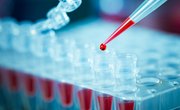
The structure of double-stranded DNA is universal in all living cells, but differences occur in the methods for extracting genomic DNA from animal and plant cells. Although genomic DNA lives in the nucleus of cells, the amount and purity of extracted DNA depends on the type and size of the cell. For example, certain cells contain more DNA and impurities than others. Read on to learn more about DNA extraction differences.
General DNA Extraction
If you treat plant and animal cells with a soapy substance, it will degrade the lipids in the cell and nuclear membranes. Then, the DNA mixture will separate from the cell membranes and proteins. Next, you can use alcohol to precipitate the DNA in the solution. Depending on the amount in the sample, DNA may be visible with the naked eye. However, keep in mind that this simple procedure does not necessarily produce DNA of high purity.
Plant and Animal Cells
Plant cells differ from animal cells because of their rigid cell wall and organelles like the chloroplast. They also contain proteins and enzymes that play a role in photosynthesis. Some plant cells have polyploidy, meaning they have more than one copy of each chromosome per cell. In addition, cellular processes occurring in plants such as photosynthesis produce a range of secondary metabolites. Animal cells do not have a cell wall, but still need chemicals like sodium dodecyl sulphate (SDS) to disrupt the cell membrane to release genomic DNA.
Plant DNA Extraction
Plant genomic DNA is more difficult to extract because of the plant’s cell wall. You can remove it by homogenization or by adding cellulase to degrade the cellulose that makes up the cell wall. In addition, the metabolites present in the plant cell may interfere with genomic DNA extraction by contaminating the DNA sample during the precipitation process.
Animal DNA Extraction
Peripheral blood leukocytes are the main source of animal genomic DNA, but sample collection is difficult because the blood must come directly from the animal. Blood contains a range of compounds like proteins, lipids, white blood cells, red blood cells, platelets and plasma, which can contaminate the DNA sample. However, the primary contaminant of animal DNA extracted from blood samples is heme, which is the non-protein component of hemoglobin.
The DNA Differences
The differences between plant and animal DNA lie in the sequence of bases in the helix. Compounds found in plant cells are absent in animal cells, and DNA base sequences reflect this. Also, the genomic plant DNA is often larger than animal DNA. These differences also affect extraction methods, yield and the purity of DNA.
References
About the Author
Keiron Audain specializes in topics related to science, technology and health. He holds a Bachelor of Science in pharmaceutical chemistry from Queen Mary, University of London, as well as a Master of Science in virology from Imperial College London.
